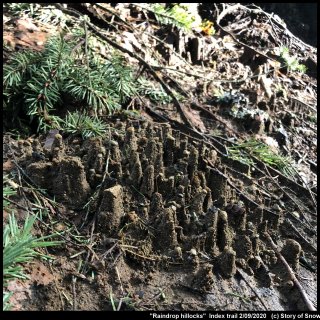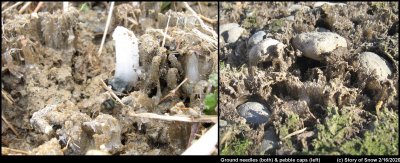| « Hoar Frost on Plastic | The Curious World of Ice and Snow: Part 3 of 3 » |
Raindrop Hillocks and Ground Ice
Ever see these small centimeter-scale hillocks in dirt or sand, usually topped by a small pebble or twig? To me, they look like a miniature mountain landscape. A brief reflection on their appearance suggests erosion by raindrops: The drops fall down on and near the larger grain (e.g., pebble), pushing the smaller grains down, leaving the larger ones to stick up above. In this way, a scene of tiny hillocks emerge. I call them "raindrop hillocks".
Click on any image to enlarge it.
Soft, easily compactable soil seems necessary to their formation. Just toss some loose dirt into a pile, then come back after a heavy rain and you are likely to see something similar. But further reflection may present some difficulties. For example, some hillocks occur where the soil should not be loose. The above image presents one such case: here the soil was on a well used trail where the soil had long been compacted. Clearly such soil could not be so easily carved by tiny raindrops. The case pictured below is on a level sandbar after a river shifted course. Where did the sand go that was up near the peaks? It seems that the sand must have originally been very loose. How could this be?
In both cases, the areas were in places likely to have had the ground freezing. So, I suspect that the ground had previously frozen and thawed, the growth of the ground needles loosening and expanding the soil. The image below shows ice pushing up dirt and rocks, the left showing both needle ice and what I call a "pebble cap" (the tall, thick white column of ice on the pebble), the right showing how needle ice can even push up larger rocks.
If this is correct, that is, the raindrop hillocks were possible because of frozen ground, then in this sense (and for these cases), they are the results of ice. Actually, ice was likely crucial to their formation in two ways: one, the ground freezing, causing ground needles to push up the dirt, making the soil loose, and two, the raindrops that compacted the soil around the hillocks must be relatively large, drops that could only be formed via the ice process in clouds.
However, I don't think these two processes of soil loosening by ice and rainfall completely explain the raindrop hillocks. For example, why does the soil in the hillock seem compact and dense? Careful observation of their formation is needed. And I doubt the explanation will be simple. For example, after I discovered the hillocks in sand in 2009, I tried to recreate them by loosening up some nearby sand and applying artificial rain from a watering can. I did get bumpy ground, but it didn't look like the hillocks. So, my hasty experiment did not get the expected result. That's the way it often goes.
--JN


